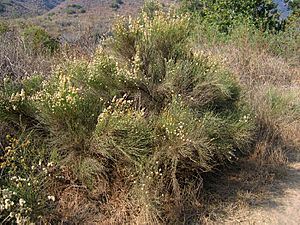California broomsage facts for kids
Quick facts for kids California broomsage |
|
|---|---|
 |
|
| Scientific classification | |
| Kingdom: | |
| (unranked): | |
| (unranked): | |
| (unranked): | |
| Order: | |
| Family: | |
| Tribe: |
Senecioneae
|
| Genus: |
Lepidospartum
|
| Species: |
L. squamatum
|
| Binomial name | |
| Lepidospartum squamatum |
|
California Broomsage (Lepidospartum squamatum) is a cool flowering shrub. It belongs to the daisy family, just like sunflowers! People also call it Scale Broom because of its tiny, scale-like leaves.
Contents
Where Does California Broomsage Grow?
This special plant is native to the mountains, valleys, and deserts. You can find it in central and southern California. It also grows in Baja California and Arizona.
Preferred Growing Spots
California Broomsage loves sandy or gravelly soils. It often grows in dry areas called alluvial habitats. Think of places like arroyos, which are dry creek beds. This plant is so common in these areas that it helps scientists know they are in an "alluvial scrub" habitat.
What Does California Broomsage Look Like?
California Broomsage is a large shrub. It can grow taller than two meters (about 6.5 feet)! It has a wide, rounded shape.
Branches and Leaves
Its branches are covered in soft, woolly fibers. The leaves are super tiny, usually less than 3 millimeters long. That's why it's sometimes called "Scale Broom"!
Flowers and Seeds
The plant produces flower heads at the ends of its branches. These can be single heads or small groups of up to five. The flower heads are round and flat, like a disc. They have many small, yellow, tube-shaped flowers called disc florets. There are no flat "petals" (ray florets) like you see on a daisy.
After the flowers bloom, they turn into seeds. Each seed is a narrow achene, which is a small, dry fruit. It has a fluffy, dull white or light brown top called a pappus. When many of these seeds are ready, the plant looks very cottony because of all the fluffy pappi!
Pollinators
When California Broomsage is in bloom, it attracts many different pollinators. These helpful visitors include various kinds of bees, colorful butterflies, and even moths. You might also spot large, striking tarantula hawk wasps visiting the flowers.

